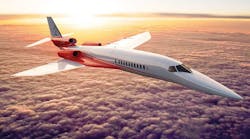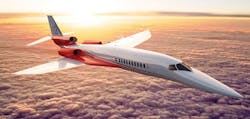Download this article in PDF format.
One trend seems to prevail across all industries: The faster the technology—whatever it is—the better. Perhaps this is due to the fact that transporting goods and people faster connects directly to the economy.
However, this trend failed to take hold with the Concorde, which offered supersonic flights starting in 1976. Supersonic flight eventually became too expensive and regulated, and the Concorde was grounded in 2003. In 2015, Machine Design published an article on the technology that planned to make supersonic travel possible again. Today, 3D printing is being added to the toolbox to accelerate plans for another attempt at cost-effective supersonic flight.
On that front, Stratasys recently announced a three-year partnership with Boom Technology, a company focused on supersonic flight. Their plan is to use fused deposition modeling (FDM) and Stratasys’ expertise to generate advanced composite tooling and parts for this lofty goal of developing new high-speed aircraft.
Specifically, Boom’s XB-1 Supersonic Demonstrator will need quick tooling and part iterations. The firm is expecting Stratasys’ FDM-based Fortus 450mc and F370 3D printers to produce production-grade thermoplastics for on-demand parts, as well as advanced manufacturing tools that perform even under aviation’s most challenging environments.
A high-precision mold is CNC machined from a block of high-density tooling foam. Some of the molds are 3D-printed. (Courtesy of Boom Technology)
Supersonic flight isn’t new, as evidenced with the Concorde, but as mentioned, it’s just not cost-efficient. However, 3D printing is changing that tune by helping to accelerate air travel while reducing development time and part complexity.
According to the ReportsnReports study, “The Global Aerospace 3D Printing Market to Grow at 55.85% CAGR during the period 2016–2020,” the primary driver of 3D printing in the aerospace market is the miniaturization of jet engines. The ability of 3D printing to print complex parts, and turn multiple parts made by traditional processes into one part, does not inhibit printing. As engineers become more aware of 3D printing’s abilities, and are free to be more creative, this process is poised to change the way we fly.
An intricately shaped variable geometry inlet uses shockwaves to compress oncoming Mach 2.2 air, efficiently slowing to the ideal subsonic speed for the engine. Digitally controlled movable surfaces precisely position shock waves to achieve ideal compression at a wide range of speeds and flight conditions, while blow-in doors provide extra airflow for takeoff.
The goal of Boom’s XB-1 is to cost-effectively fly 2.6 times faster than any aircraft in the market today. This would reduce the flight from New York to London to about three hours. However, the potential of sonic booms would limit the craft to only this route or general overseas routes. Breaking the sound barrier over land is prohibited or highly regulated due to the damage and intolerable sound that comes from the boom of flying faster than sound.
The Aerion AS2 wing uses supersonic laminar flow control to limit sonic booms. It will also carry instrumentation that lets flight crews know if they are flying over a portion of the lower atmosphere, thus protecting the earth’s surface from any sonic-boom effects.
Fortunately, researchers have been working on reducing booms caused by supersonic flight. For example, another aircraft called the Aerion AS2 is able to fly efficiently at about Mach .95 over regulated areas, but can operate at speeds up to about Mach 1.2 without producing a boom on the ground. Once cost-effective supersonic flight is achieved, it might also bring more funding and interest to sonic-boom research.
With all of the talk about supersonic flight, hyperloops, and digging underground, ultimately the key to going fast is cost-efficiency.




